Have a superior day on the water, gain access to remote fishing spots, and get away from the crowds... but remember... the best fishing kayaks are selling out fast!
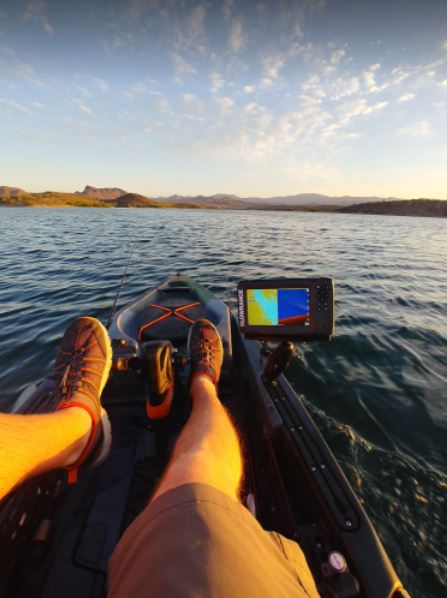
So, you’ve caught the bass fishing bug, huh? The early mornings, the thrill of the chase, the finesse of casting in that sweet spot. But, you’re missing a crucial part of your bass angling gear. And no, it’s not another expensive reel or fancy lure. You’re after the best fishing kayak to get you out onto the water, right in the heart of the action.
The fishing kayak is not just a boat, but a stealthy battle wagon made for sneaking up on unsuspecting bucketmouths. It’s a tool that turns an ordinary fishing trip into an extraordinary one.
It’s your fishing companion that, when chosen wisely, will help you land the big ones and truly earn those bragging rights.
But how do you find the best fishing kayak that aligns with your bass angling exploits?
Key Takeaways...
Back in the day when I first got into bass fishing, I remember the excitement of choosing my very first fishing kayak. It felt like a pivotal moment, a true fisherman’s rite of passage. From my years of experience and a whole lot of trial and error, here are a few key points that I’ve found crucial in selecting the best fishing kayak:
- Purpose: It’s essential to know what you want to do with your kayak. Will it be solely for fishing, or are you planning to do other activities, like bird watching or recreational paddling? This determines the type of kayak you should go for.
Why it matters: You don’t want to end up with a whitewater kayak when your main goal is to stealthily approach a school of bass.
- Storage: Always consider how much gear you’ll be bringing along on your fishing trips.
Why it matters: This ensures that your choice can accommodate your needs without turning your fishing expedition into a juggling act.
- Stability and Comfort: You’ll be spending hours on your kayak, so it’s important to ensure it’s stable and comfortable.
Why it matters: Your focus should be on the thrill of landing a big one, not on balancing your craft or nursing a sore back.
- Pedal vs. Paddle vs. Eclectic: Pedal and eclectic motor kayaks are easier on your body and they keep your hands free for casting and reeling in, while paddle kayaks are lighter, easier to maneuver, but take more work to operate.
Why it matters: You want your kayak to complement your fishing style, not complicate it.
- Size and Weight: The size and weight of the kayak impact its portability and storage.
Why it matters: You don’t want to be the guy who bought the perfect kayak but can’t transport it to the lake.
Types of Fishing Kayaks
When you’re looking to land that next lunker, the type of kayak you use can make a heck of a difference. It’s not just about having a seat on the water, it’s about choosing a vessel that matches your style, your ambition, and most importantly, your comfort. Let’s reel off some of the popular types:
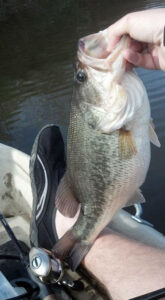 A. Sit-On-Top Kayaks
A. Sit-On-Top Kayaks
These boats keep you perched high and dry, giving you a bird’s-eye view of the water. They can come plain-Jane with very little bells and whistles, and some can come outfitted with a ton of nifty extras like rod holders, gear tracks, advanced drive systems, and even electronics ports.
Pros: You get full freedom of movement, easy to carry a ton of extra tackle and gear, simple access to your tackle, and easy to transport. The key advantage here is stability. You’ve got yourself the most stable kayak category, which makes it ideal for when you’ve got a big ol’ bass fighting on the end of your line
Cons: The downside is, you’re more exposed to the elements, they’re harder to paddle against the wind, and they’re heavier than sit-inside kayaks.
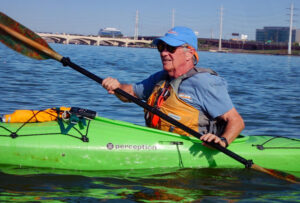 B. Sit-Inside Kayaks
B. Sit-Inside Kayaks
Sit-inside kayaks protect you more from the elements and give you a cozy cockpit to hunker down in, offering more protection from the wind and spray.
Pros: These yaks can make a big difference on those chilly early morning trips when the bass are biting, but the weather’s still brisk. Lighter than sit-on-top kayaks, and they’re more sleek (cuts through the water easily). Also easy to transport.
Cons: It’s a pain in the butt learning getting in and out (and it really sucks if you have bad knees), it’s harder to access your gear, and sometimes water gets inside, so you’ll need to buy a bilge pump!
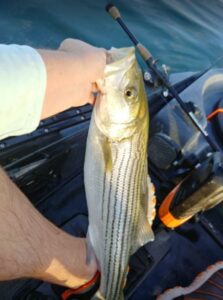 C. Pedal Kayaks
C. Pedal Kayaks
Pedal kayaks are high-tech sit-on-top bass fishing platforms. Rather than using a paddle, these bad boys employ a pedal drive system to get you moving.
Pedal kayaks are more expensive, but for many, this is a small price to pay for having the best fishing kayak experience.
Pros: With your hands free for casting and reeling, they can really change your game when you’re flipping jigs or working a topwater frog across a lily pad field.
Cons: On the flip side, the mechanism can get tangled in heavy cover, and the added weight makes them harder to transport. If you have bad knees this can put some extra stress on them.
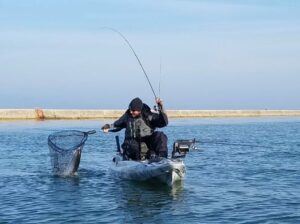 D. Motorized Kayaks
D. Motorized Kayaks
These are the Porsches of the kayak world, complete with electric or trolling motors.
These are best fishing kayaks for those who have a bad back, bad knees, and for those who are out of shape, but want all the benefits of kayak fishing. This motorized kayak lets you zoom over the water without breaking a sweat.
If you’re all about less paddling and more fishing, then a kayak with a motor might just be your ticket. Remember though, you’ll need to keep an eye on the battery life.
Pros: They can get you to your secret fishing hole quicker than you can say “Bassmaster”.
Cons: These are the more expensive type of kayak, and you’ll need to buy a battery. But hey, these tend to be 1/10th of the price of a bass boat which makes these motorized kayaks bargain!
E. Tandem (2-seater) Kayaks
Designed for two, tandem fishing kayaks are all about shared experiences. They provide more room for gear, but require synchronized paddling. They’re also wider and more stable, making them less likely to capsize.
Pros: For shared water adventures, a tandem fishing kayak is ideal. A two-person design gives you enough room for all your fishing gear, so you never have to leave anything behind. These kayaks are wider for stability, making them safer and more stable for fishing.
Cons: The increased size and capacity provide some challenges. These kayaks demand synchronized paddling, which takes practice and may not suit all paddlers. Their bulk may also impede your movement.
Additionally, their bigger size can make transportation and storage more difficult than single-seater kayaks, so you’ll need the space and equipment to handle one.
Finally, when ever you’re casting you have to be extra careful. You don’t want to hook your fishing buddy in the face accidentally.
F. Portable Kayaks
Portable kayaks include inflatable and folding models. They’re like the travel rods of the kayak universe, easy to pack up and take anywhere.
Pros: They’re great if you’re tight on space or like to pack your yak in the trunk for a spontaneous fishing trip.
Cons: However, they can be a bit less stable and durable than their rigid counterparts, so they might not be the best pick for rough waters, gravel or oyster beds.
Factors to Consider When Choosing a Fishing Kayak
Time to dive in, fellas. Now that we’ve covered the types of kayaks, let’s untangle the factors you need to consider when choosing the best fishing kayak for your angling needs. There’s no one-size-fits-all here. Your choice is going to depend on a whole lot of things, just like picking the right bass lure for different conditions.
A. Purpose and Location of Fishing
Think about where you’ll be casting your line. Freshwater or saltwater? The material of your angling kayak needs to withstand the environment. Also, consider the water condition. Will you be fishing on calm lakes or braving rough seas? A kayak built for serene lakes might not cut it when the waves start rolling.
B. Stability vs Speed
Here’s a biggie – the toss-up between stability and speed. Having a yak that doesn’t flip when a trophy bass bites is crucial, but so is the ability to quickly glide over to the perfect fishing spot. It’s about finding the right balance, like matching your reel to your rod.
C. Comfort and Seating Position
Don’t overlook comfort, guys. If you’re planning an all-day trip, a comfy seat is a must, just like your favorite recliner. Consider the seating positions too – high vs low. High seats give better visibility and casting distance, while low seats are more stable.
D. Standability
You ever tried standing up in a canoe? Tricky, right? Well, some kayaks are designed to let you stand and fish. This gives you a great vantage point to spot those sneaky bass lurking in the shallows.
E. Storage Capacity
You wouldn’t go to a cookout without your cooler, would you? Same rule applies here. Consider the storage for your gear and rods. If you’re the kind who likes to bring an entire tackle shop with you, then you need a kayak for fishing with enough storage.
F. Price
Last but not least, your wallet’s got a say in this too. Just like there’s a price difference between a spinnerbait and a swimbait, there’s a cost difference between the various types of kayaks. Do your homework and find a fishing kayak with pedals, a motor, or whatever else you need that fits your budget.
Remember, the ultimate goal is to get you on the water, catching bass, and having a great time. Take these factors into account and you’ll be one step closer to landing your best fishing kayak. Now, let’s go rip some lips!
Additional Features to Look Out For
A. Customization Options
First off, customization options. Don’t think of your yak as just a floating platform. It’s your battle station, and every good angler knows the importance of a well-equipped arsenal. Look for kayaks with plenty of gear tracks, rod holders, and spaces to add accessories that you might need. After all, every angler has a unique style.
B. Mounting Systems for Electronics
On to the high-tech stuff. Just like you wouldn’t ignore your depth finder when hunting for those deep-dwelling bucketmouths, don’t overlook mounting systems for your electronics. Fish finders, GPS, heck, maybe even a GoPro to capture that epic battle – you’ll need a place to mount ’em. Some kayaks come pre-rigged with mounting systems, while others will let you add your own.
Making Your Decision
Choosing the perfect kayak for fishing isn’t just about features, though. It’s also about feeling. Just like you’d test drive a new truck, try to get out on the water in a few different yaks before you make your decision. There’s no better way to see if a kayak is right for you than to take it for a spin.
And hey, don’t be too quick to discount the secondhand market. Just like a used rod can still haul in whoppers, a used kayak can be just as fishable as a new one.
Check out online marketplaces, local sports shops, or even fishing forums. You might just land a steal of a deal on a top-notch pedal drive kayak or even an electric kayak.
So fellas, keep these points in your tackle box when you’re on the hunt for your next fishing kayak. Now, let’s get out there and reel ’em in!
Frequently Asked Questions (FAQs)
A. Is a pedal kayak better than a paddle one for fishing?
Let’s get the ball rolling with this one. Now, a pedal kayak gives you hands-free operation, which means you can focus on casting and reeling. But remember, they can be a tad heavier and costlier.
Paddle yaks, on the other hand, are lighter and give you a bit of an arm workout. As to which is better, it boils down to your fishing style and the waters you’re planning to conquer.
B. Can I fish effectively from a portable kayak?
Inflatable or folding kayaks can be a solid choice for fishing, especially if storage or transportation is a concern. They may not be the first choice for tackling big, rough waters, but for calm lakes and rivers, they do the job just fine.
C. What is the benefit of a high seating position in a fishing kayak?
High seating, huh? This is a hot topic among us anglers. Higher seating can offer a better vantage point for spotting fish, and it can be easier on your back. But bear in mind, it can affect the kayak’s stability. So it’s all about finding the right balance that suits your comfort and stability needs.
D. Should I always opt for a fishing kayak with a large storage capacity?
Storage is key for longer expeditions or if you plan to haul in a big catch. But, if you’re a minimalist angler out for a quick trip, a kayak with less storage might serve you just fine.
E. How important is it to have a fish finder on my fishing kayak?
Having a fish finder on your kayak is like having a secret weapon. It’s not a must, but it sure gives you an edge, especially when you’re fishing in deeper waters. If you’re looking for the kayak for fishermen that offers the best advantage, you might want to consider one with a mounting system for a fish finder.
F. Is it easy to fish standing up on a sit-on-top kayak?
You bet, cowboy. Many sit-on-top kayaks offer excellent stability for stand-up fishing. They typically have a flat, wide hull design that gives you the balance to cast off while on your feet. However, if you’re a newbie, it might take some practice to get your sea legs.
G. Are pedal kayaks faster than paddle?
That’s a question worth pondering. Pedal kayaks can indeed be faster, as they harness the power of your legs, which are typically stronger than your arms. They allow you to maintain a steady speed over longer distances, which can save you time in the long run. However, in shallow or rocky waters, a paddle kayak can be more maneuverable.
H. Are fishing kayaks harder to paddle?
Well, it depends on the model and design. Some fishing kayaks, especially those designed for stability, can be wider and heavier, making them a bit tougher to paddle compared to their recreational counterparts.
More articles just for you...
Funny Fishing Rules, Laws, and Regulations 2025
Crazy Fishing Laws That Will Blow Your Mind! #7 is INSANE! Strange Fishing Regulations and Laws As silly as hook and rod limits may seem,
EXPOSED! How To Use A Spinnerbait The Right Way for 2025
Are You Wondering How To Use A Spinnerbait? Or How To Work A Spinnerbait Over Grass, Logs, or Points? Well, All These Questions Are Answered
EXPOSED! Best Crankbait Colors for 2025 [Which to Buy & Avoid]
What color crankbait to use? Crankbait Color Chart I just love going into a Bass Pro Shops store and just staring at all the walls
Best Underwater Dock Lights For Fishing – 2025 Buyers Guide
Night Dock Light Fishing For Beginners Dear fellow angler, Does this sound like you? You’re someone who loves fishing but just wants to escape the
15 Best Deep Diving Crankbaits [2025 Buyers Guide – Which to Buy & Avoid]
A Complete Buyer’s Blueprint On The Best Deep Diving Crankbaits for Bass, Walleye, or Striped Bass On The Market Today Fishing deep diving crankbaits can